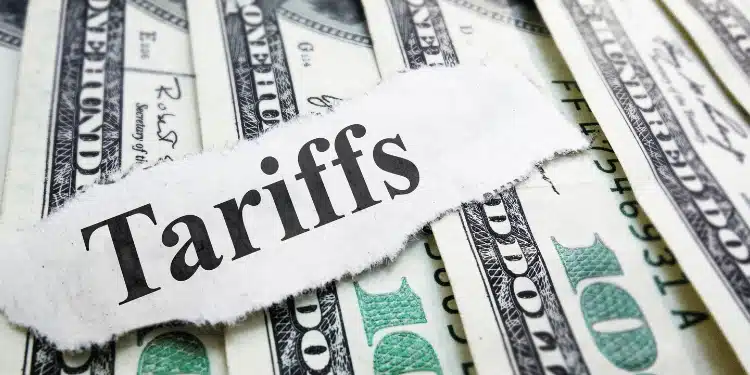Global Trade Tensions Threaten South African iPhone Market: What You Need to Know
Understanding the US-China Trade War Escalation
Trump’s Increase of Chinese Tariffs
Tensions between the US and China hit a significant high when President Trump raised tariffs on Chinese imports from 104% to 125%.
This move was part of a broader strategy to exert pressure on China and address longstanding grievances about trade imbalances and intellectual property theft.
The expectation was that higher tariffs would make Chinese goods more expensive, compelling businesses to source their products from other countries or return manufacturing to the US.
This drastic tariff increase, however, did not go unanswered.
China responded with its own set of retaliatory tariffs targeted at American goods, signaling that the trade conflict was far from a resolution.
Retaliatory Measures Between US and China
As the US imposed stricter tariffs, China quickly reciprocated, creating a cycle of retaliatory measures that exacerbated the trade war.
The tit-for-tat tariffs impacted various sectors, with electronics, agriculture, and automotive industries feeling the significant pinch.
This relentless exchange demonstrated a willingness on both sides to endure economic pain to achieve their strategic objectives.
Impact on Global Trade Relationships and Supply Chains
The US-China trade war extended its influence well beyond the borders of both superpowers, sending ripples through global trade relationships and supply chains.
Companies that relied on Chinese manufacturing, like Apple, faced increased production costs due to tariffs on Chinese components and assembly.
This disruption forced businesses to reconsider their supply chain strategies, exploring alternatives that often proved complex and expensive.
The financial markets also responded to the uncertainty with volatility.
Businesses feared the long-term implications of sustained higher tariffs, such as increased operational costs and reduced access to key markets, which could ultimately lead to higher consumer prices globally.
As we explore further chapters, we’ll delve into how these global tensions specifically affect South Africa, including the implications for local markets and consumer electronics like the iPhone.
South Africa’s Position in the Trade Conflict
New Tariffs on South African Goods
As the US-China trade war escalates, the spotlight also turned to countries like South Africa.
President Trump imposed a 30% tariff on South African goods, citing claims that South Africa had applied a 60% tariff on US imports.
However, these allegations have been met with contention.
The dispute over these tariff percentages adds another layer of complexity to the already fraught global trade environment.

Disputed Tariff Claims
The US allegations that South Africa imposes a 60% tariff on American imports have created friction.
South Africa disputes these claims, arguing that the actual tariffs are much lower.
This disagreement could significantly impact diplomatic and economic relations between the two countries, especially if they fail to reach common ground.
Suspension of Reciprocal Tariffs
Adding another twist to the scenario, the Trump administration announced a three-month suspension of all “reciprocal” tariffs, with the notable exception of those targeting China.
This temporary reprieve gives South Africa some breathing room to negotiate and hopefully resolve the tariff dispute without further escalating tensions.
With these reciprocal tariffs in limbo, South Africa might avoid immediate economic pressure, but the long-term effects remain uncertain.
The situation underscores the delicate balance countries must maintain in an interconnected global economy.
As these trade skirmishes unfold, the broader implications for global supply chains and markets, including consumer electronics like the iPhone, will become an increasing concern.
Looking ahead, the complexity of these trade issues will likely continue to ripple through various sectors, with tangible impacts on both global and local markets.
iPhone Production and Supply Chain Complexities
Global Assembly and Component Sourcing
Understanding the complexity of iPhone production, especially in the context of global trade tensions, requires looking at how Apple’s supply chain operates.
Approximately 80% of iPhone assembly occurs in China Daily Mail, a hub that plays a critical role in Apple’s manufacturing process.
Besides China, India and Vietnam also contribute to iPhone assembly, though to a lesser extent.
The components required to build an iPhone are sourced from about 50 different countries worldwide.
These include key parts like processors from South Korea, camera modules from Japan, and various electronic components from Taiwan.
This vast network makes iPhone production a quintessential example of globalization, where efficiency and cost management are paramount.
Challenges of Relocating Manufacturing
Given the intricate nature of Apple’s supply chain, relocating iPhone manufacturing to the US presents several challenges.
One of the primary hurdles is the specialized manufacturing infrastructure available in China, which includes skilled labor, advanced technology, and an established supply network.
Replicating this setup in the US would not only be time-consuming but also prohibitively expensive.
Moreover, the cost of labor in the US is significantly higher than in China.
This would further inflate the production costs, making iPhones less competitively priced.
Apple has expressed concerns over these challenges, suggesting that moving production to the US is not feasible under the current circumstances.
Impact on South African Market
The ongoing trade war and the resulting tariffs have a cascading effect on global markets, including South Africa.
As the cost of production increases, Apple will likely adjust its pricing strategy to maintain profit margins.
This could mean higher prices for iPhones in South Africa, impacting the local consumer electronics market.
The broader implications also extend to other consumer electronics, not just iPhones.
As production costs rise due to shifting supply chains and increased tariffs, consumers may have to brace for overall price hikes in electronic goods.
With the stage set by these supply chain complexities and trade tensions, we move towards understanding the potential impact on South African iPhone prices, considering Apple’s strategies and market predictions.
This will shed light on how local consumers might be affected and what lies ahead in the realm of consumer electronics.
Potential Impact on South African iPhone Prices
Expected Increase in Production Costs due to Tariffs
As the US-China trade war intensifies, South African consumers are bracing for a potential hike in iPhone prices.
The 30% tariff that the US has imposed on South African goods, combined with the recent increase of tariffs on Chinese imports from 104% to 125% by President Trump, is expected to drive up the production costs of iPhones significantly.
Given that 80% of iPhone assembly occurs in China and that components are sourced from about 50 countries, the extra costs associated with these tariffs will inevitably be passed on to consumers.
Apple’s Strategy for Maintaining Profit Margins
Apple, like any other company, is primarily focused on maintaining its profit margins.
With the predicted rise in production costs, Apple faces tough decisions.
The company might choose to absorb some of these additional expenses, which could negatively impact its growth margins.
However, it is more likely that Apple will increase the retail price of iPhones to offset the higher production costs.
Ben Barringer, a global technology analyst at Quilter Cheviot, suggests that the tariffs into the US will influence the cost of making the iPhone, while the Chinese tariff will raise the retail price in China, leading to a broader rise in global iPhone prices.
Predicted Effects on the Local Consumer Electronics Market
The ripple effect of these increased production costs is particularly concerning for the South African market.
As iPhone prices climb, local consumers may find these devices becoming less affordable.
This escalation could also impact other consumer electronics that rely on components sourced from or assembled in countries affected by the tariffs.
The increased costs will not only affect iPhones but potentially other gadgets, creating a chain reaction in the local market.
Looking ahead, the consumer electronics market in South Africa could experience a shift as retailers and consumers adapt to these new price dynamics.
With rising costs, buyers might explore alternative smartphone brands or wait for discounts and promotions to mitigate the financial impact.
As the global trade landscape continues to evolve, South African consumers and businesses will need to stay agile and responsive to these changes.
Future Implications and Consumer Considerations
Long-Term Effects on Global Smartphone Prices
The escalating trade tensions between the US and China are likely to have substantial long-term effects on global smartphone prices.
President Trump’s increase in tariffs on Chinese goods to 125% means that the cost of manufacturing iPhones, which are predominantly assembled in China, will rise significantly.
With components sourced from approximately 50 different countries, many of which are also impacted by these tariffs, the increased production costs are almost certainly going to be passed on to consumers.
Consequently, South African consumers can expect to see iPhone prices soar in the foreseeable future.
Potential Alternatives for South African Consumers
As iPhone prices rise, South African consumers may start looking for alternative smartphone brands that are less affected by these hefty tariffs.
Several brands, such as Samsung, Huawei, and Xiaomi, offer high-quality smartphones at more competitive prices.
These companies, having more diversified assembly locations outside of China, could potentially be less impacted by the tariffs.
South African consumers may also explore the secondary market for refurbished iPhones or turn to less expensive models within the Apple ecosystem, like the iPhone SE.
Experts’ Outlook on the Consumer Electronics Market
Experts are painting a cautious picture for the global consumer electronics market.
Ben Barringer, a global technology analyst at financial experts Quilter Cheviot, has noted that Apple’s commitment to maintaining its profit margins will likely result in higher retail prices for its devices.
The ripple effect of this price adjustment will not only influence iPhones but could extend to other electronics as well.
This means that South African consumers may experience a broader increase in prices for various gadgets and smart devices.
The ongoing trade war underscores the volatility and interconnectedness of global supply chains.
For South African businesses and consumers, staying adaptable and informed will be crucial in navigating these challenges while seeking cost-effective alternatives.
As we progress, the broader impacts on global trade dynamics will become increasingly pronounced, highlighting the need for strategic economic decisions to mitigate potential adverse effects on local markets.





